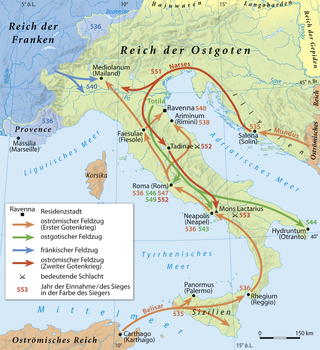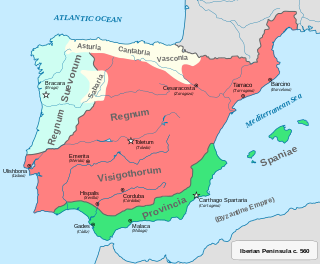Related Research Articles
The 530s decade ran from January 1, 530, to December 31, 539.
The 540s decade ran from January 1, 540, to December 31, 549.
The 550s decade ran from January 1, 550, to December 31, 559.

Year 552 (DLII) was a leap year starting on Monday of the Julian calendar. The denomination 552 for this year has been used since the early medieval period, when the Anno Domini calendar era became the prevalent method in Europe for naming years.

Year 554 (DLIV) was a common year starting on Thursday of the Julian calendar. The denomination 554 for this year has been used since the early medieval period, when the Anno Domini calendar era became the prevalent method in Europe for naming years.

Year 549 (DXLIX) was a common year starting on Friday of the Julian calendar. The denomination 549 for this year has been used since the early medieval period, when the Anno Domini calendar era became the prevalent method in Europe for naming years.

Year 553 (DLIII) was a common year starting on Wednesday of the Julian calendar. The denomination 553 for this year has been used since the early medieval period, when the Anno Domini calendar era became the prevalent method in Europe for naming years.

Narses was, with Belisarius, one of the great generals in the service of the Byzantine Emperor Justinian I during the Roman reconquest that took place during Justinian's reign. Narses was a Romanized Armenian. He spent most of his life as an important eunuch in the palace of the emperors in Constantinople.

Totila, original name Baduila, was the penultimate King of the Ostrogoths, reigning from 541 to 552 AD. A skilled military and political leader, Totila reversed the tide of the Gothic War, recovering by 543 almost all the territories in Italy that the Eastern Roman Empire had captured from his Kingdom in 540.

The Liang dynasty, alternatively known as the Southern Liang or Xiao Liang in historiography, was an imperial dynasty of China and the third of the four Southern dynasties during the Northern and Southern dynasties period. It was preceded by the Southern Qi dynasty and succeeded by the Chen dynasty. The rump state of Western Liang existed until it was conquered in 587 by the Sui dynasty.
Athanagild was the Visigothic king of Hispania and Septimania. He had rebelled against his predecessor, Agila I, in 551. The armies of Agila and Athanagild met at Seville, where Agila met a second defeat. Following the death of Agila in 554, he was sole ruler for the rest of his reign.

The Gothic War between the Byzantine Empire during the reign of Emperor Justinian I and the Ostrogothic Kingdom of Italy took place from 535 to 554 in the Italian peninsula, Dalmatia, Sardinia, Sicily, and Corsica. It was one of the last of the many Gothic wars against the Roman Empire. The war had its roots in the ambition of the Byzantine emperor Justinian I to recover the provinces of the former Western Roman Empire, which the Romans had lost to invading barbarian tribes in the previous century, during the Migration Period.
Agila, sometimes Agila I or Achila I, was Visigothic king of Hispania and Septimania. Peter Heather notes that Agila's reign was during a period of civil war following the death of Amalaric, the last member of the old Visigothic dynasty, when ambitious Gothic nobles competed openly for the throne.
Emperor Jianwen of Liang, personal name Xiao Gang (蕭綱), courtesy name Shizuan (世纘), childhood name Liutong (六通), was an emperor of the Chinese Liang Dynasty. He was initially not the crown prince of his father Emperor Wu, the founder of the dynasty, but became the crown prince in August 531 after his older brother Xiao Tong died. In 549, the rebellious general Hou Jing captured the capital Jiankang, and Hou subsequently held both Emperor Wu and Crown Prince Gang under his power, having Crown Prince Gang take the throne after Emperor Wu's death later that year. During Emperor Jianwen's reign, he was almost completely under Hou's control, and in 551, Hou, planning to take the throne himself, first forced Emperor Jianwen to yield the throne to his grandnephew Xiao Dong the Prince of Yuzhang, and then sent messengers to suffocate the former emperor.
Xiao Dong, courtesy name Yuanji (元吉), sometimes known by his pre-ascension title of Prince of Yuzhang (豫章王), was briefly an emperor of the Chinese Liang Dynasty. In 551, with the general Hou Jing in control of the imperial government at the capital Jiankang, Hou, wanting to show off his strength, deposed Xiao Dong's granduncle Emperor Jianwen and replaced him with Xiao Dong, the grandson of Emperor Jianwen's older brother Xiao Tong, who was originally the founder Emperor Wu's crown prince.

Hou Jing, courtesy name Wanjing (萬景), was a Chinese military general, monarch, and politician. He was a general of Northern Wei, Eastern Wei, and Liang, and briefly, after controlling the Liang imperial regime for several years, usurped the Liang throne, establishing a state of Han. He was soon defeated by the Liang prince Xiao Yi, the prince of Xiangdong, and was killed by his own associates while in flight. He is one of the most reviled figures in ancient Chinese history, known for his extreme cruelty to enemies and civilians. He is also known to have called himself "General of the Universe Past, Present, and Future, Commander of all Forces in the Six Directions" (宇宙大將軍、都督六合諸軍事).

Spania was a province of the Eastern Roman Empire from 552 until 624 in the south of the Iberian Peninsula and the Balearic Islands. It was established by the Emperor Justinian I in an effort to restore the western provinces of the Empire.

The Battle of Sena Gallica was a naval battle fought off the Italian Adriatic coast in the autumn of 551 between an East Roman (Byzantine) and an Ostrogoth fleet, during the Gothic War (535–554). It marked the end of the Goths' brief bid to deny the seas to the Romans, and the beginning of the Byzantine resurgence in the war under the leadership of Narses.

John, also known as John the Sanguinary, was the nephew of the rebel Vitalian and was an Eastern Roman general under Justinian I, who was active in the Gothic War in Italy and against the Gepids in the western Balkans. He was married to Justina, the daughter of Justinian's cousin Germanus.
The 551 Malian Gulf earthquake took place in the Spring of 551 in the vicinity of the Malian Gulf. It affected the cities of Echinus and Tarphe.
References
- ↑ J.Norwich, Byzantium: The Early Centuries, p. 251
- ↑ Antonopoulos, 1980
- ↑ Sbeinati, M.R.; Darawcheh R. & Mouty M (2005). "The historical earthquakes of Syria: an analysis of large and moderate earthquakes from 1365 B.C. to 1900 A.D." (PDF). Annals of Geophysics. 48 (3): 347–435. Archived (PDF) from the original on October 9, 2022. Retrieved March 2, 2011.
- ↑ Isidore of Seville, Historia de regibus Gothorum, Vandalorum et Suevorum , chapter 46. Translation by Guido Donini and Gordon B. Ford, Isidore of Seville's History of the Goths, Vandals, and Suevi, second revised edition (Leiden: E.J. Brill, 1970), p. 22
- ↑ Bury (1958), p. 116
- ↑ Greatrex & Lieu (2002), p. 118-119